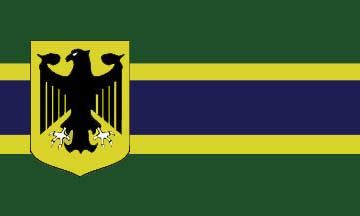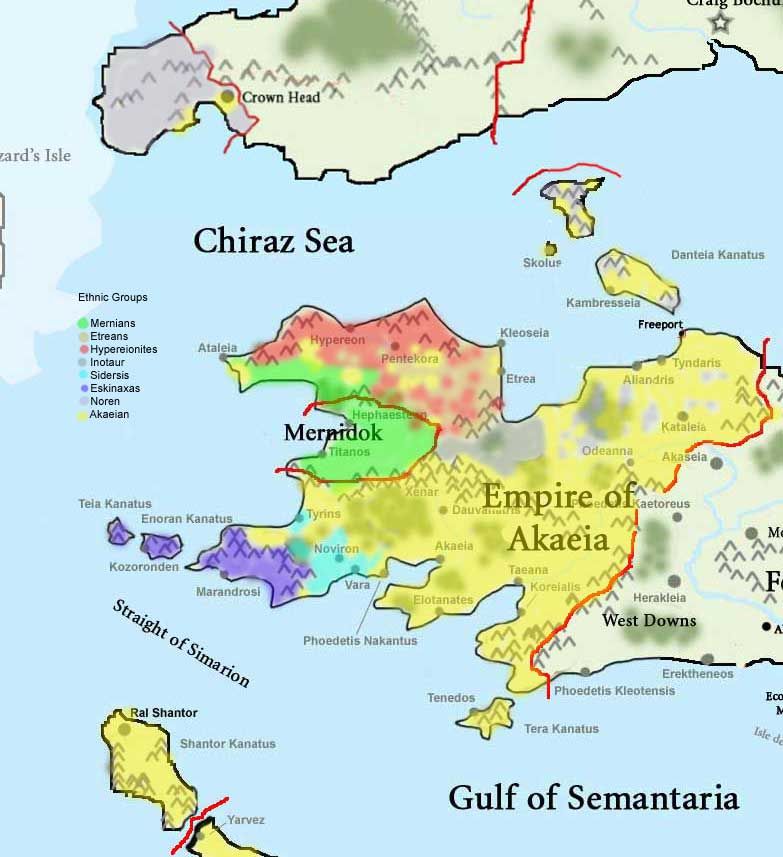Difference between revisions of "Akaeia"
(→Akaeian ethnic groups) |
|||
| Line 2: | Line 2: | ||
subject_name=[http://www.nationstates.net/cgi-bin/index.cgi/target=display_nation/nation=Akaeia | subject_name=[http://www.nationstates.net/cgi-bin/index.cgi/target=display_nation/nation=Akaeia | ||
Akaeia] | | Akaeia] | | ||
| − | flag= | | + | flag= http://img.photobucket.com/albums/v338/Belisaurius/eagleshield.jpg| |
region=[[Namura]] | | region=[[Namura]] | | ||
motto=Morality Triumphs Where Wealth Fails| | motto=Morality Triumphs Where Wealth Fails| | ||
Revision as of 16:46, 25 November 2005

| |
| Flag of Akaeia | |
| Motto: Morality Triumphs Where Wealth Fails | |
| No Map Available Yet | |
| Region | Namura |
|---|---|
| Capital | Taeana |
| Official Language(s) | Akaeian |
| Leader | Klesis Kreistohpos Antaxes |
| Population | 16.7 million |
| Currency | Taean |
| NS Sunset XML | |
Contents
The Akaeian Government
-- The Dual Obligation --
A core Akaeian philosophy of government is the Dual Obligation. Outlined in the famous book On Citizens and Governments by the philosopher Auriastes Palantianteias, the Dual Obligation is expressed as the duty of every citizen to sacrifice and work for the common good, and of the government to seek out the best for the people it governed. This belief is the cause for extensive education and welfare programs across Akaeia, as well as a land for the landless program intended to keep unemployment down. At the same time, many of Akaeia's most honored citizens are honored for their devotion to the common good and the state.
-- Akaeian Government --
After the recent coup under Crown Kreistophos Antaxes against the former government, the Akaeian state has been reoganized according to the First Reformation Mandate. Due to the failure of the previous government to manage the Empire and the needs of its peoples, the Crown has taken it upon himself to reorganize the state and reform the government.
-- The Academy of Civil Service --
A uniquely Akaeian institution is the Academy of Civil Service. Although education was a standard requirement for Akaeian civil servants during both the Early and Middle Empires, it was not until the middle of the Middle Empire that the idea of an Academy of Civil Service came to be. Any Akaeian between the ages of 18 and 30 are welcome to attend the Academy of Civil Service without personal cost. They must, however, keep their grades above 85%, as well as meet service requirements and maintain a respectable life style. Before the Education Mandate of 1391, all government employees were drawn from graduates of the Academy of Civil Service.
At the Academy, a student learns the in depth history of the Akaeian Empire, seen from the various policies enacted and their affects upon the Empire. Major problems common between the nations of Namura, such as defense, are taught so that the actions taken by foreign rulers are compared with those taken by Akaeian rulers, and the impacts of the policies are compared and contrasted. The Academy is not meant to teach a certain view among its students; rather, different viewpoints are encouraged and debates on the differing merits of policies throughout history common. The Academy provided the Empire with a well-educated bureacracy during the Middle Empire which functioned even when the Crownship did not. Eventually, the continuing decline of the Middle Empire became total collapse, but it is largely due to the students of the Academy that the government recongregated in Xenar and that the Interregnum Empire managed to survive at all.
-- The City of Akaeia --
From a refugee camp to the Imperial City, Akaeia has seen a great deal of change over the nearly two thousand years since the city's founding. During the Early Empire, the city experienced an extensive population boom that fueled Imperial expansion and began a tradition of civic improvements with which the Akaeian government is often associated. With the second largest population of any Akaeian city, at 729,011, the city of Akaeia is the center of a significant portion of trade and administration, rivalled only by the massive city of Taeana. Akaeian Cities
-- Important Persons --
-- Important Government Documents --
- The First Reformation Mandate
- The Second Reformation Mandate
- The Treaty of Elotanates
- The Treaty of Yarvez
- The Unification Treaty
- The Education Mandate of 1391
- The Declaration of 1092
- The Intentions of Akaeia
Akaeian Aristocracy and the House System
About the House System
Beginning under the fifth Crown, Arkastos Solaneios II, individuals who have made significant contributions to the Akaeian Empire have been recognized by the raising of their family to House status. If any member of that family, however, commited a crime against the state, then that whole family can be demoted from House status by the Crown. All members of that family are thereby responsible to maintain their family's status as a House. This meritocratic aristocracy is a hallmark of Akaeian society. The newest House is the Onaden House, raised to House status for the services of Edan Onaden for the Crown in the defense of the Tsyhtema colony. The Skenosix House is pending demotion for the actions of Tauen Skenosix, who betrayed the state during the Three Day's War, but his subesquent actions for the liberation of Crown Ioshuad Iardaneios II from pirates will most likely allow for his family's continuation as a House.
Akaeian ethnic groups

Major Ethnic Groups
These three ethnicities are distinctive both in caracteristcs and in strong nationalist tendancies from the other ethnicities. The largest, by far, are Ethnic Akaeians and those minor ethnicities under that umbrella term.
- Ethnic Akaeians: Ethnic Akaeians live predominantly in the Menaros River Valley (Dauvanatris, Xenar, Akaeia (City)) and in the provinces of Okkoreion (Kataleia, Odeanna, Tyndaris, Aliandris), Kambresseia (Kambresseia, Skolus), and Irilitos (Taeana, Elotanates, Koreialis, Tenedos) in the Northeast. There has however been a millenium of intermarraige and so millions can claim some ethnic blood. Prior to the Interregnum, citizenship was a monopoly of Ethnic Akaeians, but Ioshuad Iardaneios the Great extended citizenship to all during the early years of the Reconquest. Ethnic Akaeians have traditionally been associated with brown hair and brown or blue eyes. Brown hair and blue eyes are considered a mark of blessing and has been associated with the Iardaneian Dynasty. Ethnic Akaeians are Catholics and there is a strong tradition of civil service. Ethnic Akaeians are more likely than other ethnic groups in the Empire to serve in the military or the government. Many believe Akaeians should do their best in all things so that Akaeia is made great by their works. The military cities of Ral Shantor and Tenedos are also predominantly inhabited by Ethnic Akaeians.
- Eskinantines: The Eskinantine People broke off from the Empire during the Interregnum and established a highly successful trading state under House Eskinaxes. Up until the Panselle War the nation remained independant of the Akaeian Empire, at which point the nation was forcibly annexed to the Empire. There is a strong sense of Eskinantine nationalism. The mountain range separating Eskinanthus from the rest of the continent has helped to preserve the Eskinantines as a people without connections to the wider Empire. Olive colored skin and darker hair and eye types. The Eskinantines are the most militant ethnic group in Akaeia. Their two major settlements are Marandrosi and Kozoronden
- Inotaur: The Inotaur Tribes live on the northern side of the middle mountain range in Akaeia. The Inotaur are known for their horsemanship and have been allowed to continue practicing their old ways because they are some of the best horsemen anywhere. In the two hundred years before the beginning of the Akaeian Empire, the Inotaur were greatly feared and brought about the fall of the Hypereionite Empire at the First Battle of Pentekora. There are only a few thousand Inotaur but the Empire has allowed them to live undisturbed for centuries, asking only for a certain amount of horses and horsemen be contributed to the Imperial Army. The horses given to Sicinia in Ioshuad Iardaneios II's trip were bred by the Inotaur and were some of the very best horses Akaeia had to offer. Inotaur are traditionally associated with black hair and dark eyes of any shade. They have two major settlements: Audoreth and Ulan Ude
Minor Ethnic Groups
Minor ethnic groups fall under the umbrella term Akaeian or Ethnic Akaeian. For the most part these groups are small in number or have been predominantly assimilated so that they maintian only a small amount of real difference from the ethnic Akaeian majority.
- Noren: The inhabitants of the Tsyhtema colony are collectively known as the Noren to continental Akaeians. Blond Hair is prominent with blue or green eyes, typically. Koreiander and Crown's Head.
- Mernidokian: The majority of this group resides in the former province of Thrakaeia, now the nation of Mernidok. More a nationality than an ethnic group. The largest concentration of this group outside Mernidok is in the city of Ataleia, where about 70% of the inhabitants are ethnic Mernidokians.
- Sidersite: The classical peoples from before the rise of Akaeia have lingered on mostly in the province of Novitreia (Noviron, Vara, Tyrins.) They are predominantly followers of the Sidersis religion and have maintained many old traditions and cultural past times into the modern day. Sidersites have darker hair colors and olive colored skin. The new colony on Psei'Danis is predominantly Sidersite.
- Hypereionite: The former ethnic people who built the Hypereionite Empire and died in its service. Some of the old aristocracy have maintained themselves to this day, most notable the Baroness of Etrea, who is the last living direct descendant of the last royal house of Hypereion. Lighter hair colors. Concentrated in Hypereion, Pentekora, Kleioseia, and Etrea. Among the former aristocracy there is some move for independance, but it does not hold with the wider people, which is why the Northern Empire rejoined Akaeia so quickly after it's departure last fall.
The Akaeian Military
Culture
A Concise History of the Empire of Akaeia
For information begining with the opening of Namura, click on the appropriate link below.
Relations with Mernidok and the Concordance of the Four
Founder's Day and the Zagorlad War
Yarvez Revisited and the Defensive Alliance
The Crownship of Kreistophos Antaxes and the Reformation Mandates
Yarvez and the Unification Treaty
The Dual Crownship and the Crown's Head incident
Ureian Atreiadeias and the Crownship
Ioshuad Iardaneios II and the Collapse of Akaeia
The First Civil War and the Three Day's War
Historians in Akaeia divide the history of the Empire and the region which it came to dominate into six different eras. The first two eras, the Mythological and Classical, are before the beginning of the Empire. The Early Empire, Middle Empire, Interregnum, and Reconquest Empire are all after the founding of the Empire. Concerning the Mythological Era there are no real written records, save those passed down by word of mouth and recorded in the Classical Era. There are four main exceptions to this rule: the reigious books of the Sidersis religion. There are extensive records of the Classical, Early Empire, and Middle Empire Eras, but significant portions of information were lost during the Interregnum and many records are scattered across the Empire. Regarding the Reconquest Empire there are meticulous records, but msot of which are not of particular interest to the reader. For more information, click on the Era of interest:
The Mythological Era
-- The Founding of the Empire, The Year 0 --
The Middle Empire
The Interregnum
Reconquest Empire
